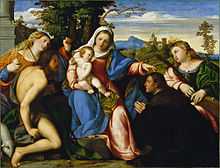Sacred conversation

In art, a sacra conversazione (Italian pronunciation: [ˈsaːkra ˌkonvɛrsaˈtsjoːne]) meaning holy/sacred conversation, but usually left in Italian, is a depiction of the Virgin and Child (the Virgin Mary with the infant Jesus) amidst a group of saints in a relatively informal grouping, as opposed to the more rigid and hierarchical compositions of earlier periods.[1]
The form developed during the Italian Renaissance as artists replaced earlier hieratic triptych or polyptych formats for altarpieces with compositions in which figures interacted within a unified perspectival space. Early examples are Annalena altarpiece by Fra Angelico and others by Filippo Lippi. Among other artists to depict such a scene are Piero della Francesca, Giovanni Bellini, Paolo Veronese, and Andrea Mantegna. Early examples such as the Bellini illustrated rarely show actual "conversation" or much interaction, though this may be seen from the 16th century on, as in the Madonna and Child with Saints Luke and Catherine of Alexandria by Titian. The setting is often architectural, but may be a garden or, especially later, an open landscape.

The group subjects known as Hortus conclusus, with Mary and often others in a closed garden, and the Virgo inter virgines, Mary with virgin saints, are related types, most popular in the 15th century.
See also
References
- ↑ Glossary: Sacra Conversazione. National Gallery, 2013. Retrieved 30 January 2013.
| Wikimedia Commons has media related to category:Sacra Conversazione. |